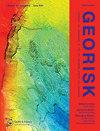试图比实时更快地模拟熔岩流:使用VolcFlow的拉帕尔马的一个例子
IF 4.8
3区 工程技术
Q1 ENGINEERING, GEOLOGICAL
Georisk-Assessment and Management of Risk for Engineered Systems and Geohazards
Pub Date : 2022-12-10
DOI:10.3390/geohazards3040027
引用次数: 0
摘要
Cumbre Vieja火山(也称为Tajogaite火山,2021年9月19日至12月13日,西班牙)的喷发是成功应急管理的一个例子。吸取的教训尚未充分披露,是否可以进一步改进应对措施也是如此。后者可能包括预测熔岩流淹没流变特性的工具,以及与火山爆发有关的其他问题(即灰烬落下和气体排放)。这项研究的目的是探索一个科学的、开源的、随时可用的熔岩流建模代码(VolcFlow)是否足以进行熔岩就位预测,重点是火山喷发的前七天。我们只使用危机期间发布的公开数据和之前可用的数据集。熔岩的流变性,以及排放率,在模拟熔岩流时是最重要的,而这些数据并不容易获得。卫星熔岩范围分析使我们能够初步估计其速度、平均流出流量和流动粘度。通过将Jaccard形态测量指数最大化,并将模拟的7天内熔岩淹没的区域与同一时间尺度下熔岩的实际推进进行比较,对这些估计进行了数值调整。手动搜索这个优化问题的解决方案实现了85%和60%的形态匹配。我们估计在火山爆发的前24小时,熔岩流的流量约为140 m3/s。我们发现排放率逐渐下降到60 m3/s。在7天的剩余时间里,粘度从最初的8 × 106 Pa s(即42 × 103 Pa)变化到4 × 107 Pa s和35 × 103 Pa。对9月27日以前熔岩就位的模拟表明,与观测结果相比,熔岩厚度的分布是可以接受的,而且几何上非常吻合。校正后的模型计算所需的时间比模拟时间短;因此,流模型可用于应急管理。但是,速度和准确性都可以通过一些额外的开发和收集数据的指导来提高。而且,一旦模型准备好,管理的可用时间随着预测时间的延长而准线性增加。这表明,只要对熔岩有充分的流变描述,在紧急情况下具有类似特征的预测反应是可以实现的。本文章由计算机程序翻译,如有差异,请以英文原文为准。
Attempt to Model Lava Flow Faster Than Real Time: An Example of La Palma Using VolcFlow
The eruption of Cumbre Vieja (also known as Tajogaite volcano, 19 September–13 December 2021, Spain) is an example of successful emergency management. The lessons learnt are yet to be fully disclosed as is whether the response can be further improved. The latter may include tools to predict lava flow inundation rheological characteristics, amongst other issues related to volcanic eruptions (i.e., ash fall and gas emission). The aim of this study was to explore if a scientific open-source, readily available, lava-flow-modelling code (VolcFlow) would suffice for lava emplacement forecasting, focusing on the first seven days of the eruption. We only the open data that were released during the crisis and previously available data sets. The rheology of the lava, as well as the emission rate, are of utmost relevance when modelling lava flow, and these data were not readily available. Satellite lava extent analysis allowed us to preliminarily estimate its velocity, the average flow emitted, and flow viscosity. These estimates were numerically adjusted by maximising the Jaccard morphometric index and comparing the area flooded by the lava for a simulated seven-day advance with the real advance of the lava in the same timescale. The manual search for the solution to this optimization problem achieved morphometric matches of 85% and 60%. We obtained an estimated discharge rate of about 140 m3/s of lava flow during the first 24 h of the eruption. We found the emission rate then asymptotically decreased to 60 m3/s. Viscosity varied from 8 × 106 Pa s, or a yield strength of 42 × 103 Pa, in the first hours, to 4 × 107 Pa s and 35 × 103 Pa, respectively, during the remainder of the seven days. The simulations of the lava emplacement up to 27 September showed an acceptable distribution of lava thickness compared with the observations and an excellent geometrical fit. The calculations of the calibrated model required less time than the simulated time span; hence, flow modelling can be used for emergency management. However, both speed and accuracy can be improved with some extra developments and guidance on the data to be collected. Moreover, the available time for management, once the model is ready, quasi-linearly increases as the forecasting time is extended. This suggests that a predictive response during an emergency with similar characteristics is achievable, provided that an adequate rheological description of the lava is available.
求助全文
通过发布文献求助,成功后即可免费获取论文全文。
去求助
来源期刊
CiteScore
8.70
自引率
10.40%
发文量
31
期刊介绍:
Georisk covers many diversified but interlinked areas of active research and practice, such as geohazards (earthquakes, landslides, avalanches, rockfalls, tsunamis, etc.), safety of engineered systems (dams, buildings, offshore structures, lifelines, etc.), environmental risk, seismic risk, reliability-based design and code calibration, geostatistics, decision analyses, structural reliability, maintenance and life cycle performance, risk and vulnerability, hazard mapping, loss assessment (economic, social, environmental, etc.), GIS databases, remote sensing, and many other related disciplines. The underlying theme is that uncertainties associated with geomaterials (soils, rocks), geologic processes, and possible subsequent treatments, are usually large and complex and these uncertainties play an indispensable role in the risk assessment and management of engineered and natural systems. Significant theoretical and practical challenges remain on quantifying these uncertainties and developing defensible risk management methodologies that are acceptable to decision makers and stakeholders. Many opportunities to leverage on the rapid advancement in Bayesian analysis, machine learning, artificial intelligence, and other data-driven methods also exist, which can greatly enhance our decision-making abilities. The basic goal of this international peer-reviewed journal is to provide a multi-disciplinary scientific forum for cross fertilization of ideas between interested parties working on various aspects of georisk to advance the state-of-the-art and the state-of-the-practice.

 求助内容:
求助内容: 应助结果提醒方式:
应助结果提醒方式:


